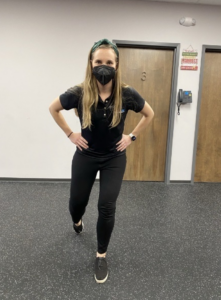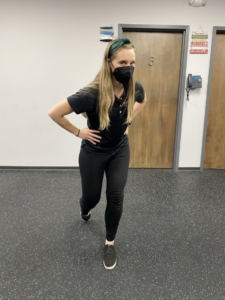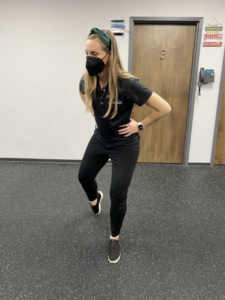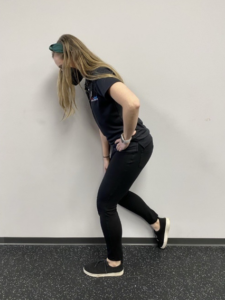Written by Katelyn Sheehan, PT
Unlock the potential of your hip and glute muscles with a transformative exercise that addresses a common concern among many individuals – the challenge of truly feeling the engagement of their hip and glute muscles during activities like running, lifting, golfing, and playing pickleball. In some cases, the key to overcoming this challenge lies in enhancing the ability to stretch the back of your hip through eccentric contractions. Picture this: a simple yet effective exercise that not only stretches those elusive hip muscles but also actively engages them. The main goal of this exercise is for you to keep your affected leg (patient’s left in the example below) completely still as your pelvis and torso rotate as a unit over the fixed leg, while working on your balance. If you feel safe with your balance, give it a try!



1) First start with a mini squat (not pictured).
2) Shift your weight to your affected side (patient LEFT as shown in this picture).
3) Keep your shoulders stacked in line with your front hip, knee, and ankle as you bring the unaffected leg back to a resting position on the ground (picture 1). Now most of your weight should be on your affected leg.
4) Then keep the space between your ribs and your pelvis the same on both sides as you turn as far to the left (picture 2), then to the right (picture 3) while maintaining the mini squat and the majority of your weight on the affected leg.
5) Repeat this 10-12 times on each leg for 2-3 sets.
PROBLEM SOLVING:
If you feel this in your thigh muscles:
- Try not to sit as far down into the squat.
- Make sure your nose is over your toes (you might need to hinge forward more through the hips). See image below as an example.

If you are feeling this in your back:
- Keep your index finger on your lower rib cage and your pinkie on your pelvis, when you rotate be sure that the pelvis and rib cage move as a unit.
- Make sure that your ribs are not lifted up to the sky (your back should be flat, not arched)
Still having trouble?
- Talk to your physical therapist for possible modifications or pointers.
Empower your pelvic health journey with JAG PT – where your well-being is our priority. Book an appointment with JAG Physical Therapy at one of our convenient locations in NJ, NY, or PA or contact us for more information.
Learn More About Pelvic Health from JAG Physical Therapy:
- How to Support your Hips and Pelvic Floor Before Being Active
- Dry Needling in Pelvic Health
- Understanding Pelvic Floor Dysfunction: Symptoms, Causes, and Treatment
- The Importance of Pelvic Floor Therapy for Women and Men
